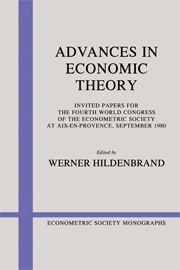Book contents
- Frontmatter
- Part I Economics of incentives
- Part II Information and the market mechanism
- Part III Non-Walrasian economics
- Chapter 4 Developments in non-Walrasian economics and the microeconomic foundations of macroeconomics
- Chapter 5 On equilibria with rationing
- Part IV Repeated games
- Part V Topics in competitive analysis
- Part VI Applied macroeconomics
- Part VI Industrial organization
Chapter 4 - Developments in non-Walrasian economics and the microeconomic foundations of macroeconomics
from Part III - Non-Walrasian economics
Published online by Cambridge University Press: 05 January 2013
- Frontmatter
- Part I Economics of incentives
- Part II Information and the market mechanism
- Part III Non-Walrasian economics
- Chapter 4 Developments in non-Walrasian economics and the microeconomic foundations of macroeconomics
- Chapter 5 On equilibria with rationing
- Part IV Repeated games
- Part V Topics in competitive analysis
- Part VI Applied macroeconomics
- Part VI Industrial organization
Summary
After the seminal contributions of Clower (1965) and Leijonhufvud (1968), there has been a considerable renewal of interest in non-Walrasian economics as a way to provide rigorous microfoundations to macroeconomics. The basic idea behind all the models in this area is that prices may not clear the markets at all times, and thus that adjustments can, at least partially, be carried out through quantities. Such a theme is evidently at the heart of Keynesian economics, as Clower and Leijonhufvud pointed out. Further progress in the domain has in a large proportion been made along two lines.
The first is the construction of general microeconomic models abandoning the assumption of competitive equilibrium on all markets. A first category of these models assumes some degree of price rigidity and studies the associated quantity adjustments: Glustoff (1968); Dreze (1975); Benassy (1975a, 1975b, 1977); Younès (1975); Grandmont-Laroque (1976); Malinvaud-Younès (1978); Bohm-Levine (1979); and Heller-Starr (1979). A second category addresses the problem of noncompetitive price formation: Negishi (1961, 1972); Benassy (1976); and Hahn (1978). As we shall see in Section 1.5, these two types of models can actually be synthesized.
The second line of research consists of constructing specific aggregated models to study macroeconomic themes such as unemployment or inflation: Solow-Stiglitz (1968); Younès (1970); Barro-Grossman (1971, 1974, 1976); Grossman (1971); Benassy (1973, 1974, 1978a, 1978b); Malinvaud (1977); Negishi (1978, 1979); Hildenbrand-Hildenbrand (1978); Dixit (1978); and Muellbauer-Portes (1978).
- Type
- Chapter
- Information
- Advances in Economic Theory , pp. 121 - 146Publisher: Cambridge University PressPrint publication year: 1983
- 2
- Cited by



